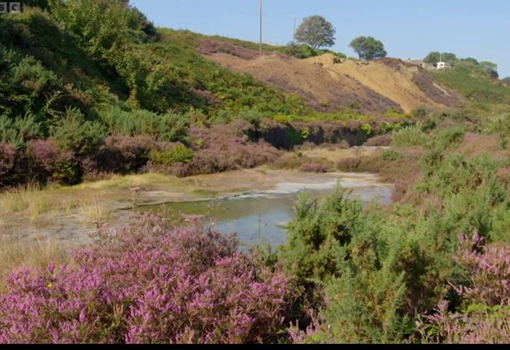29th March
Easter in Cornwall normally means full STEAM ahead with tourism and hospitality, but not this year. Water, in various forms, is holding us all back.


I am not usually guilty of moaning about the weather, I mean what’s the point? Get your mac and wellies and go for it would be my philosophy. But somehow the extended period with no sunshine for a full 5 months, since November, has cost me many £s in extra biomass, is keeping the site closed and has really got me down mentally and physically. Beastly bronchitis is everywhere it seems, and I unfortunately succumbed at the weekend. Am I alone? Absolutely not. So many friends seem to be similarly rundown and indeed the entire Cornwall tourist sector is struggling. Bookings are way down generally, added to which last week there was a mini version of Boscastle flash floods, which struck Mawgan Porth, a popular north coast surfing centre. Six cars were swept away, business premises filled with mud and water, stock ruined etc. etc. https://www.cornwalllive.com/news/cornwall-news/pub-flooded-people-rescued-after-9189127
Future for flood resilience – collaboration of locals is the only way
The people of Mawgan Porth, a tiny little community, have all come together, hands to the pumps literally, to save what they can and try to be open for the Easter weekend. Impressive collaboration and a model to study and copy. In fact, I do question whether, with more and more such events of extreme weather ahead, any professional company or organisation has a vision for solving the problem. Feels to me that the best outcome will always be if locals get together and support each other, developing practical strategies first. Unfortunately, though, there are numerous laws to consider when dealing with management of water. The top water companies (in the headlines again this week) may have deep enough pockets to ignore laws, but locals do not. (NB I have chosen not to pick up on the BBC report and most recent outburst from Feargal Sharkey, but do find it on YouTube if you have not heard him before, search Feargal Sharkey speaks to Victoria Derbyshire on the Tory Sewage scandal! ..)
To resume … for all the reasons above, with PL24 Par River catchment example in mind, I feel there is little hope. We are not dealing with a one-off flash flood, but continually problematic backing-up of water behind a 10 foot weir. I’ve been thinking for a long time that the best way to be permitted to lower the water level here would be a more complete size of rock rack fish pass, but all landowners, the county council, parish council, EA, SW Water, Network Rail, old uncle Tom Cobbley an all would have to work together and support a plan. After 5 years of observing, I do not see it happening.
Still, I am committed to concluding my role in this, with a final report. Focusing on the legalities, with my usual colleague, Bob Hatton, we are now re-examining the professional’s ideas, not for flood first but for fish management. This may in fact give pointers for the flooding too. The most stringent legal document to be consulted is this one:-
https://ifm.org.uk/wp-content/uploads/2020/09/Fish-Pass-Manual.-GoodVersion-pdf.pdf
And a 2nd helpful, very practical one with photos is from a place called The River Restoration Centre, a manual which tells of work done on the Isle of Man. Happily the people involved have provided contact info, so I hope to reach them one way or another, next week.
Picture 1 is from Manx Utilities; Picture 2 is our weir in January 24. https://www.therrc.co.uk/sites/default/files/general/MOT/final/12.5_neb.pdf


The weir is hidden behind the little island and tree in the centre of this photo. Water has worn away a side wall, allowing a mini rock ramp to be created. We will need to landscape the entire area, and if possible build a new structure to carry leat water over the top, extending an historic aqueduct and joining the new and old into one channel.
A final point – the list of predicted costs for rock ramp creation make clear that it is by far the cheapest option.


Beavers, Cornwall; Otters, California;
Following on from the fish theme, and with apologies if you know this already, but this seems the right moment to remind any reader who hasn’t understood the fact before that beavers do not eat fish. They are herbivores. Find out more about beavers, their food and their lives along the River Tamar (and beyond), if you can attend a talk by Matt Holden, Devon Beaver Project Officer.
Lanhydrock Memorial Hall, PL30 5AE, Wednesday 3rd April, 19:00 to 21:00 (approx.)
Back to the theme – otters, yes they do eat fish. The California latest environmental news is that Sea otters eat constantly and one of their favourite snacks is the striped shore crab. By a planned process of hunting bans and habitat restoration, otters have been brought back into the area, to eat crabs, which for some time have been turning the coastline so full of holes it looks like Gorgonzola! This restoration programme will save a California marshland.
Cornwall Climate Care – latest in their list of brilliant films
| POWER TO THE PEOPLE LAUNCH – DATES AND BOOKING LINKS 25th April 2024 Screening at The Regal, Wadebridge followed by Q&A Get your tickets here – Wadebridge Screening 30th April 2024 Screening Hall, The Savoy, Penzance followed by Q&A Get your tickets here – Penzance Screening 2nd May 2024 Screening at The Plaza Cinema, Truro, followed by Q&A Get your tickets here – Truro Screening 9th May 2024 Screening at Calstock Arts, followed by Q&A Tickets available on the door or here – Calstock Arts Screening 26th May Screening at Maker-with-Rame Community Hall, Kingsand, followed by Q&A Get your tickets here – Kingsand |
| We hope to see you at a screening soon! All the best, The Cornwall Climate Care Team HAVE YOU SEEN THE REST OF OUR FILMS? You can see the full series to date here |
New project – how to explain Net Zero to our youngest children
Between the rain, I eventually found a window of fair weather and managed to make a short film, designed to put forward ideas for a pilot project and make a joint application for Levelling Up £s. The idea of ‘from Forest to STEAM’ (preliminary illustration was included for you last time) is to help all Early Years and Infant learning centres, where they enjoy working outdoors or would like to develop in that way, to build areas for studying plants and geology, with a focus on grasping what can be learned for Climate Hope.
Q How can you explain fundamentals of climate change to a 3 year old. Answer, think about our breathing and relate what happens in respiration to some balloons! We breathe one way, oxygen (green balloon) in and CO2 (red one) out, while trees go the opposite way. They are our partners in breathing! PS Looking at my own photo, I will not include methane & nox for such young ones, but possibly will for Juniors.


For the forest section of activities, we will support children as they learn to plant some little cuttings and celebrate helping Forest for Cornwall to grow. The Forest project originally aimed to plant 1m trees by 2030; now they say the target will be met 5 years ahead e.g. 2025. I love this! A positive story at last.
For simplicity, I have started taking cuttings from my enormous hedges of lowly griselinia, knowing they will grow like weeds, with almost no attention. I call Griselinia lowly because nobody seems to rate it for any other reason than the functional role of bordering a garden or yard. Yet, in its native New Zealand, and also a location I found in West Wales, it can grow to be amazing big trees, with air exposed roots.

Having spent a while on the trees, then we will look at what happens when they eventually decay and die. I have noticed so many beech trees in our woods showing signs of rot and falling, recently. Huge trunks across pathways, in the rivers and streams.It certainly looks like more than in the past.
OFFICIAL WORD – Currently, in the face of rapid climate change, beech may be endangered in its geographical and ecological range.
So, it is no surprise to hear that our beech trees are threatened, mostly by drought. But I sense that the amount and ferocity of gales is playing a part, and perhaps there may be some other kind of disease element. Have done a bit of quick research, but not found answers.
Whatever the cause, when a tree is rotting away or is burned, it lets out that CO2 it has been capturing and storing, through its life. Lots of red balloons, needed here, and that’s not good! But worse is when decomposed into a hard, black form as coal or the liquid petroleum (literally means rock oil) and then burned to drive a machine.
The first iteration of fossil fuels for heavy work was 200 years ago, of course, for running steam engines. However, not many people know there were different types of steam engine and one – called a Stirling – can operate at much lower temperatures than the boiling point needed in a standard Puffing Billy. The way it operates is with a piston that goes up and down between a cold area and a hot one. As long as the heat differential is maintained the piston will keep going.
Development of the Stirling type engine opens up new possibilities in today’s world, bringing into use warm water that is either discarded from commercial uses, lifted up out of deep mines or perhaps in the form of steam from a waste incinerator.
Over the next weeks I will be exploring much more of the background of Stirling engines and the idea that they could be a really useful addition to our sources of green energy. But for Early Years and their teachers, at coffee time, the simplest illustration is the 3rd picture, which I have borrowed from a YouTube clip.



Let me wrap up this section for now, with a reminder we will have some Steam Stories and some tree planting next Wednesday morning, April 3rd in Par. And by coincidence, the first story will be about 2 little steam driven saddle-tank engines, Bill and Ben. The Revd Awdry modelled two books in the Thomas the Tank series on Par Harbour and its china clay industry, ‘Main Line Engines’ and ‘The Mischievous Twins’. Keep your fingers crossed for me please; I really need some sunshine for that story telling session and the one on the previous day in Fowey.
Cornwall – news of Electric Buses and latest on Lithium
BUSES – Cornwall’s first electric buses will take to our streets next year, helping to cut carbon emissions and improve air quality. The Council has successfully bid for funding from the Department for Transport ZEBRA 2 fund to replace the entire Truro Park & Ride fleet with electric buses and provide a new electric bus for the Falmouth Town Service.
A further 6 electric buses are set to be introduced in south-east Cornwall as part of a bid led by Plymouth City Council and Plymouth CityBus/Go Cornwall Bus in partnership with Cornwall Council. These buses will run on the 70/A/B routes around Torpoint and the Rame Peninsula.
Richard Williams-Pears, Cornwall Council cabinet portfolio holder for transport, said:- “As we continue to invest in giving residents choices for more sustainable ways to travel around Cornwall, our public transport system should reflect our commitment to reducing carbon emissions.”
LITHIUM – Despite many hours work and conversations last summer, when my son was making his theatre show about Lithium, this week I found there were plenty of gaps in my knowledge. I learned tons, from the newly appointed Chair and Vice Chair of our Geo-Resources cluster group, both are impressive ladies and both involved in the Cornwall Lithium story. Lucy Crane is Sustainability Manager for Cornish Lithium and Suzie Doe works for Geoscience Ltd. alongside the geothermal, ground source and borehole rock mechanics groups, in order to communicate and market the services they provide.
The Lithium source is not a document but an educational video, in a cartoon style, featuring ‘Miss Molecule’ and meant to be for viewers of 9 years and above. https://www.missmolecule.co.uk/watch
Let me warn you, it is almost 30 minutes long, very full of detailed factual info, and I find it hard to believe that many Junior age children could stick with it. My suggestion is that, if would like to become better informed, you bear this in mind for a watch in the week of Friday April 19th, when I think a blog is unlikely to come together, due to further Geo-Resources demands and travel commitments.
To end, Earthshot Prize team are now producing a monthly dose of Optimistic Messages, from which I have chosen this heading. Find the rest at https://earthshotprize.org/news/monthly-optimism-roundup-for-march-2024/

Meadow Barns Events in Easter Week
EASTER TUESDAY

EASTER WEDNESDAY





